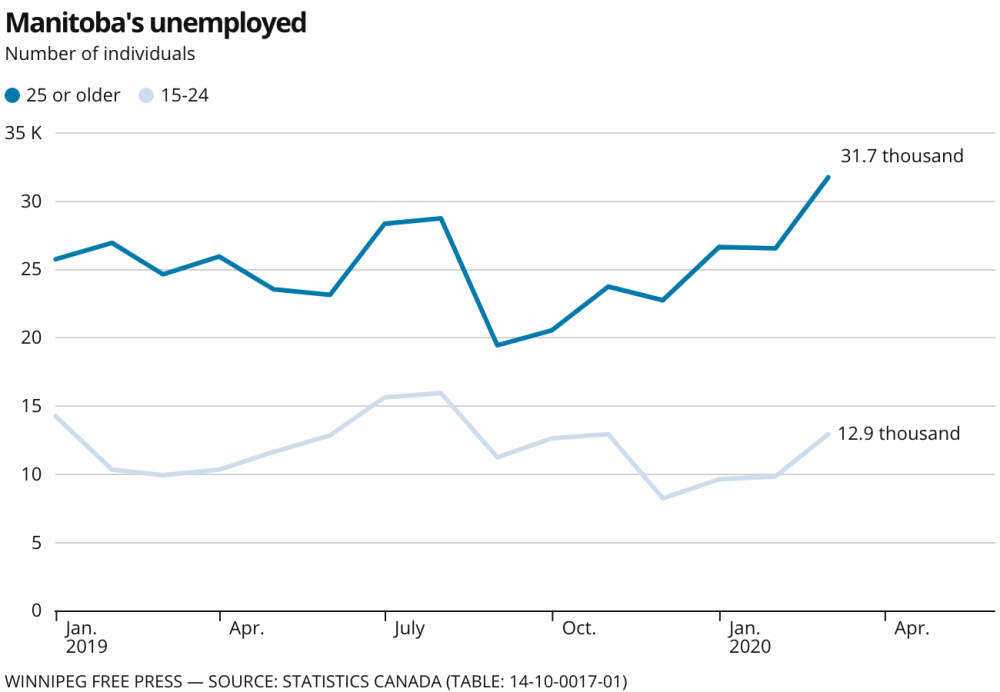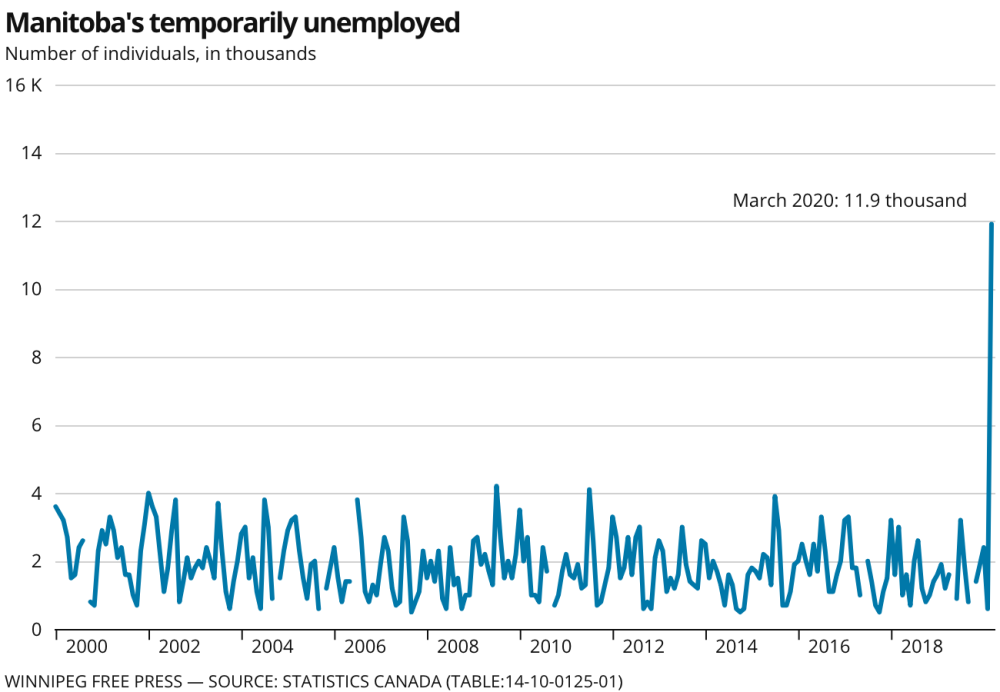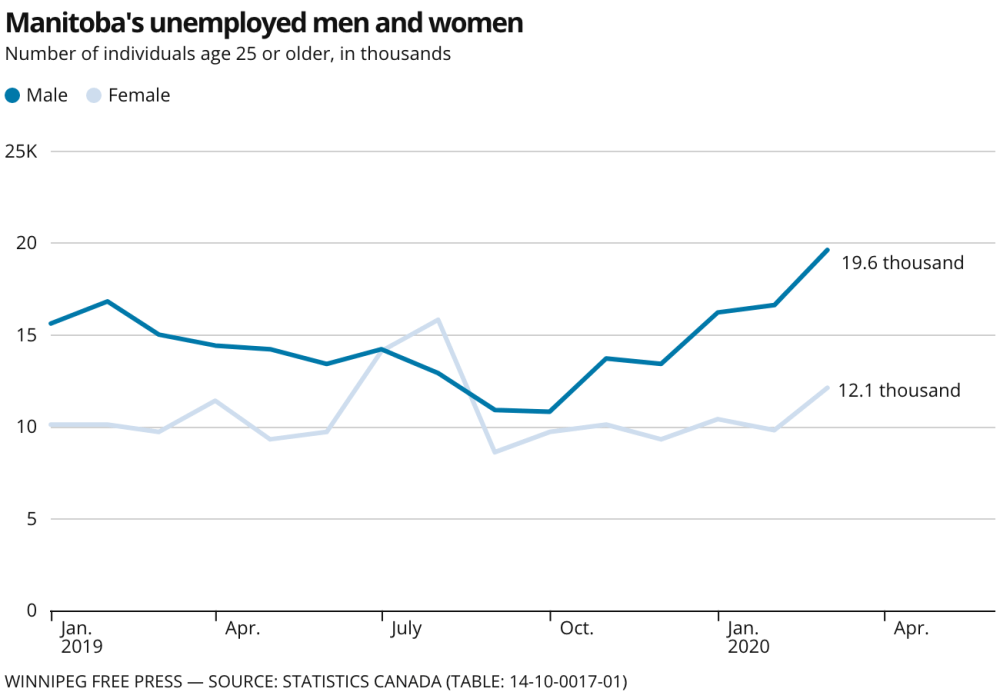Labour survey paints dire picture More than 25,000 job losses in Manitoba in March
Read this article for free:
or
Already have an account? Log in here »
To continue reading, please subscribe:
Monthly Digital Subscription
$1 per week for 24 weeks*
- Enjoy unlimited reading on winnipegfreepress.com
- Read the E-Edition, our digital replica newspaper
- Access News Break, our award-winning app
- Play interactive puzzles
*Billed as $4 plus GST every four weeks. Offer only available to new and qualified returning subscribers. Cancel any time.
Read unlimited articles for free today:
or
Already have an account? Log in here »
Hey there, time traveller!
This article was published 09/04/2020 (1758 days ago), so information in it may no longer be current.
OTTAWA — Manitoba lost more jobs in March than any month recorded over the past four decades, as COVID-19 knocks Canada’s economy into a coma.
Some 25,300 Manitobans lost their jobs last month of whom 11,900 were temporarily laid off, before the province ordered even more businesses to close.
“It’s really just a sign of how our world has changed so quickly,” said Brendon Bernard, an economist with the job-search site Indeed.com.
In its monthly labour force survey released Thursday morning, Statistics Canada reported that 3.1 million Canadians either lost their jobs or worked less than half their normal hours over the week of March 16, as Canada started closing its borders.
“The economy, and society in general, has just gone into a deep freeze,” said Bernard, who used to work for Finance Canada.
The numbers put Canada’s unemployment numbers around the peak of the 2008 financial crisis, which came after roughly nine months of turbulence, compared with last month’s sudden shutdown.
The data are especially dire for those working in restaurants, hotels, recreation and education facilities, with the most notable drops in young and temporary employees.
“The first workers to experience job losses as a result of COVID-19 are among those least able to withstand economic hardship,” Statistics Canada suggested in its Thursday analysis.
And while the 2008 recession disproportionally affected North American men in fields like manufacturing, Thursday’s data shows women aged 25-54 had a five per cent drop in employment compared to two per cent of men, possibly because women work in more front-line service jobs.
Manitoba faced a lower proportion of job losses than the four big provinces, a less stark gender breakdown.
The province has a slower decline in total hours worked than the national data; Quebec lost double Manitoba’s drop in labour hours.
Still, 2,700 people in Winnipeg reported losing their jobs during the survey week, and losses were particularly pronounced in Manitoba’s southeast and southwest.
Wayne Simpson, a University of Manitoba labour-economics professor, noted that the province was also slower to close businesses than jurisdictions harder-hit by the coronavirus.
“We all knew it was going to be bad, but it is still hard to process the numbers.”
– TD Bank economist Brian DePratto
The weeklong survey was ramping down as Manitoba started limiting how many people could patronize a business, by which point most shops in Ontario and British Columbia had already closed.
And while job losses tend to dominate the public’s focus, Simpson said he’s keeping an eye on total hours worked and how many Canadians say they’re only temporarily unemployed.
“A lot of workers are either in a state of limbo, or have some indication from their employer… they will be hired back,” Simpson said.

The figures, collected three weeks ago, have likely become much worse, economists warn, given the rise in benefit claims and the drop in online job postings.
“We all knew it was going to be bad, but it is still hard to process the numbers,” wrote TD Bank economist Brian DePratto in a Thursday research note.
Despite troubles in the oil patch and trade disruptions, Canada had managed strong employment numbers over the past three years.
“This single report wiped out 40 months of net employment gains, and the worst is yet to come,” DePratto wrote.
The Trudeau government has rolled out a series of benefits, tax breaks and wage subsidies. More than 4.5 million claims for the Canada Emergency Response Benefit have been processed.
While more measures are in the works, the parliamentary budget officer estimated Thursday that the aid package already in place will put the federal deficit at 8.5 per cent of Canada’s gross domestic product for the first time in 35 years.
Simpson is hopeful the federal benefits minimize the disruption to the Canadian labour market.
“We all hope this will be over with as little pain as possible, but it’s still early days.”
dylan.robertson@freepress.mb.ca
March 2020 Labour Force Survey
History
Updated on Friday, April 10, 2020 1:55 AM CDT: Corrects chart source
Updated on Friday, April 10, 2020 11:31 AM CDT: Corrects number of job losses.










